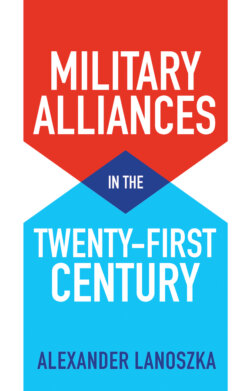Читать книгу Military Alliances in the Twenty-First Century - Alexander Lanoszka - Страница 17
1 Formation
ОглавлениеWhy do states establish military alliances? For a time, this question no longer appeared to have policy relevance and thus could only have inspired historical interest. The Bush administration may have overseen the incorporation of seven European countries into NATO, but it failed in its bid to put Georgia and Ukraine on a clear path toward eventual membership. Most importantly, under Bush’s leadership the United States opted to build a “coalition of the willing” to wage a military campaign against Iraq. Even the NATO mission in Afghanistan saw some countries place caveats over the use of their military forces there, much to the dismay and resentment of some of their partners. With Obama taking over the White House amid profound global economic crisis in 2009, military alliances seemed to have become too rigid and impractical as a tool.
Looser security arrangements were destined to be commonplace. Thomas Wilkins (2012: 54) averred that “formal military alliances [based] on the pre-WWI/Cold War paradigm have now ceased to represent the standard for allied security cooperation.” Bruno Tertrais (2004: 139) noted unequivocally that “permanent multinational alliances appear increasingly to belong to the past.” As he saw it, many US allies had grown wary of US leadership, while the United States itself came to view alliances as much more burdensome than before. Rajan Menon (2003: 16) went further and declared “the end of alliances,” be they bilateral or multilateral. He argued: “America will revert to a pattern it has followed for most of its history, operating in the world without fixed, long-term alliances and pursuing its cooperation with a range of partners.” Echoing this sentiment, Stephen Walt (2009: 137–8) wrote that, because of its global dominance, Washington “is likely to rely more heavily on ad hoc coalitions, flexible deployments, and bilateral arrangements that maximize its own leverage and freedom of action.” Similarly, Parag Khanna (2008: 324) observed that states now operate “in a world of alignments, not alliances.”
And yet barely a decade after these pronouncements were made, military alliances began to experience a revival. Seth Cropsey (2020) of the Hudson Institute has argued in favour of “[s]trengthening the US–Taiwan Alliance [sic]” in order to improve regional defense against an increasingly powerful China. At least one scholar argues that China is “on the verge of an alliance” with Russia (Korolev 2019). In the spring of 2020, India and Australia signed a mutual logistic support agreement that would allow each country to access the other’s military balance, signaling that they may be involved in more military exchanges and exercises in the future. Already across the Indo-Pacific region a patchwork of different security relationships has taken shape between countries that have previously avoided military cooperation, suggesting that new defense pacts may yet form with the goal of managing the rise of China and its attendant challenges (Simón et al. 2021). Though admittedly more of a case of alliance enlargement than of alliance formation, the United States added two new treaty allies to its roster, with Montenegro and North Macedonia joining NATO in 2017 and 2020, respectively. Indeed, the security challenge posed by Russia following its annexation of Crimea from Ukraine reanimated NATO. Some alliance scholars have spoken of how NATO could contribute to balancing efforts against China (Moller and Rynning 2021: 185). Whereas London and Washington may have had a “special relationship” in the twentieth century to confront threats in Europe and elsewhere, Tokyo and Washington may yet have one in the twenty-first century on the basis of their Security Treaty as the center of gravity in international affairs shifts toward the Indo-Pacific.
The standard view is that states establish military alliances for at least two, non-mutually exclusive, reasons. The first is that states wish to balance against a threat that they commonly face. The second motive is that strong states use the alliance relationship as a vehicle for expanding their influence over others. This is supposed to be especially true of asymmetric alliances, in which at least one member is significantly greater in military and economic capabilities than another. In these arrangements, the stronger state is able to extract key concessions from its weaker counterpart.
As this chapter illustrates, however, the problem with these standard arguments about alliance formation is threefold. First, although threat-based arguments provide a powerful explanation for why states form alliances, they remain insufficient in accounting for the patterns that we see, for the simple reason that shared threat perceptions do not always lead to formal alliances. No one set of factors will ever systematically lead states to sign an alliance, in part because alliances are costly. States sometimes might not wish to get exposed to the disputes of potential allies. Second, existing understandings overstate the concessions that even great powers can extract from weaker states by way of a treaty. And third, the foregoing explanations of alliance formation do not explain why a written alliance treaty is actually a necessary condition for achieving such ends as balancing and concession-extracting. This chapter argues that a signed alliance treaty is desirable not just for defining the terms of a commitment, but also, ironically, for injecting a certain amount of vagueness into the language of the agreement itself. Alliance treaties thread the needle between certainty and ambiguity, permitting states to be more comfortable about deepening their military cooperation, if they choose to do so.
